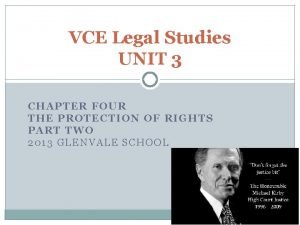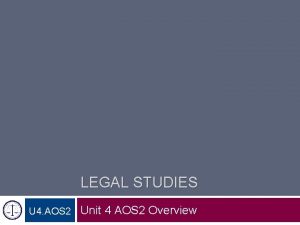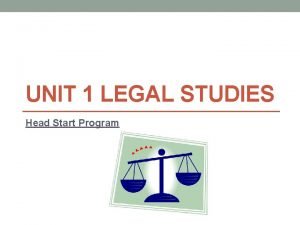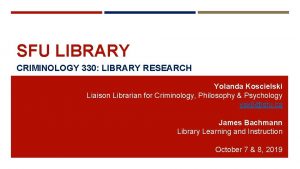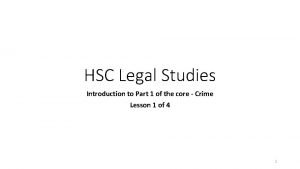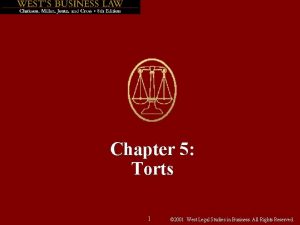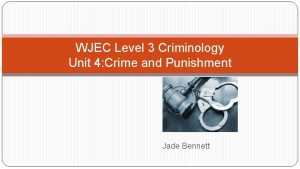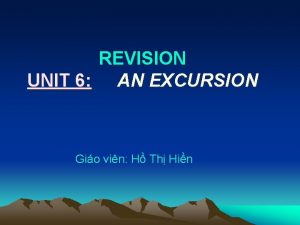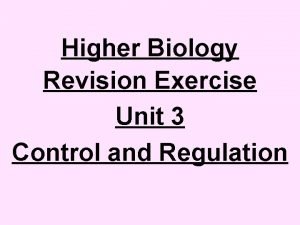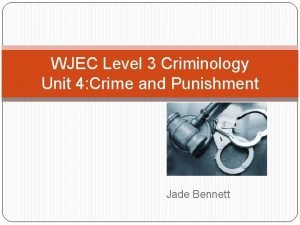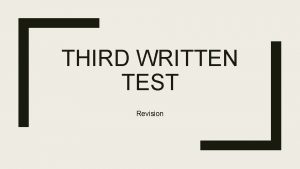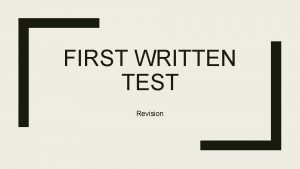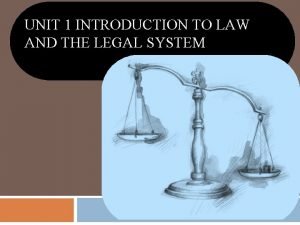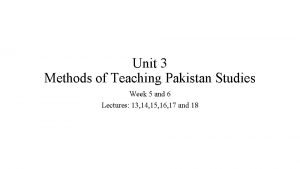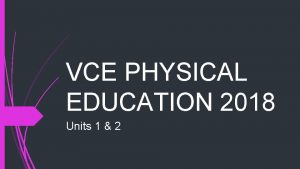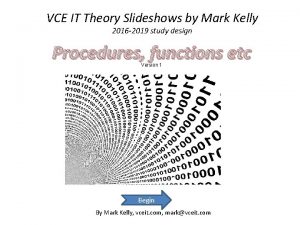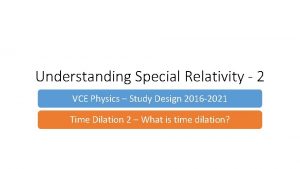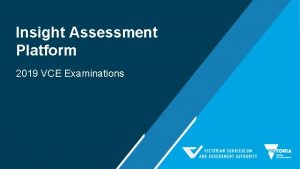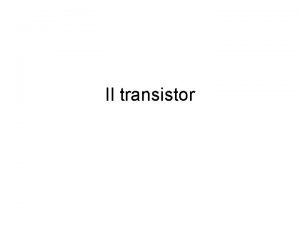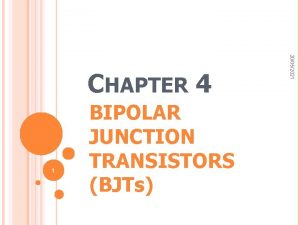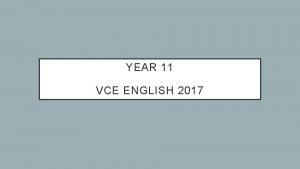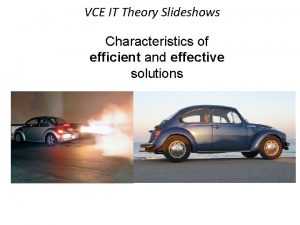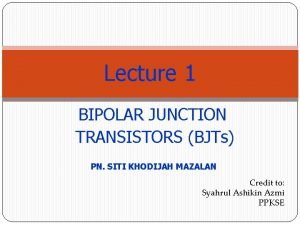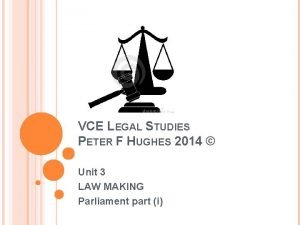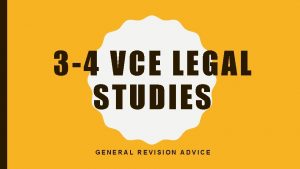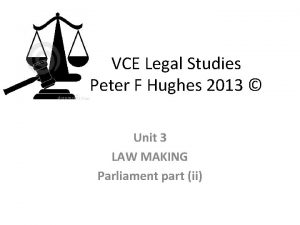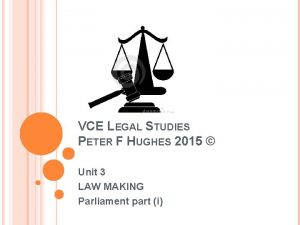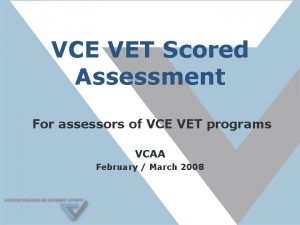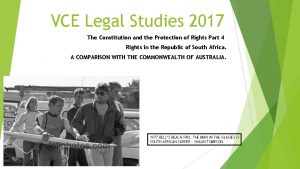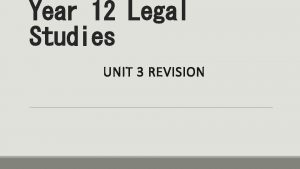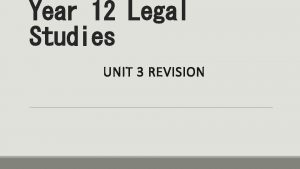Unit 4 VCE Legal Studies Revision 2014 1
























































- Slides: 56

Unit 4 – VCE Legal Studies Revision 2014 1

Chapter 5 – Dispute Resolution Methods 2

Reasons for a court hierarchy • Specialisation Enables courts to specialise in hearing specific types of cases. • Doctrine of Precedent Lower courts must follow legal reasoning (Ratio decidendi) made by superior courts in same hierarchy. • Appeals (on the grounds of severity or leniency, on the point of law) Provides for a mechanism of review • Administrative efficiency Efficient/timely resolution of disputes Cost effective Utilisation of resources Subject matter experts 3

Original & Appellate Jurisdictions 4

Role of VCAT • The main purpose and reason is to ‘provide Victorians with a low cost, accessible, efficient and independent tribunal that delivers high quality dispute resolution’. In striving to achieve this aim VCAT specialises in resolving minor civil disputes in an informal, cost-effective and timely manner, using a range of different methods of dispute resolution. 5

Resolving a dispute at VCAT 6

Dispute resolution methods used by courts and VCAT Judicial Determination • This involves going to court or VCAT and having the judge, magistrate or VCAT member decide the outcome of the case and imposing a legally binding decision • Have to follow rules of evidence and procedure • Going to court is expensive and time consuming • There is a legally binding decision and someone is made a winner and loser • There are strict rules of evidence and procedure 7

Dispute resolution methods used by courts and VCAT - MEDIATION • Uses an independent 3 rd party known as a Mediator • Allows each party a chance to express their side of the issue and their desired outcome • Does not offer suggestions • Trained to facilitate discussion and encourage co-operation to reach their own solution 8

Dispute resolution methods used by courts and VCAT CONCILIATION ARBITRATION • An unbiased 3 rd party called a Conciliator who tries to resolve a civil dispute. • This is the next step after Mediation and Conciliation • Can make suggestions to the parties in order to reach an agreement (key difference to Mediation) • The arbitrator is independent • May make suggestions in attempt to have parties mutually settle the dispute. If no mutual acceptance, will make a binding decision • Can order a resolution to a dispute – called an award • An award is a decision in favour of one of the parties • An award is legally binding and must be followed just like a court order • Any agreement is not binding so parties can choose to not follow what was agreed • Statistically however most parties observe any agreements made to avoid further costs in court procedings 9

Strengths and weaknesses of dispute resolution methods used by Courts and VCAT 10

Strengths and weaknesses of dispute resolution methods used by Courts and VCAT 11

Chapter 6 – The elements of an effective legal system 12

Fair and unbiased hearing The role of the judge Strict rules of evidence and procedure • Independent and impartial adjudicator • Strict rules of evidence and procedure govern a trial. • Both parties treated fairly and afforded equal opportunity • All parties MUST comply with rules and procedures • Ensure compliance with strict rules of evidence and procedure • Evidence that has not been obtained in accordance with the law is • Does not assist with case preparation (Inquisitorial System) • Judge is only human – mistakes can and do happen (Appeals) • Not involved in determination of a NG plea as that is the role of the Jury. generally inadmissible • Police must ensure all their evidence is gathered using correct and lawful procedures or risk their evidence being ruled inadmissible by the judge. • Prior convictions relating to the past criminal record of the accused are generally inadmissible. • Strict procedural rules exist to govern the order and manner in which a party must present their case to ensure the trial is fair. • The existence of strict rules of evidence and procedure helps ensure parties receive a fair and unbiased hearing by having parties treated consistently and giving each an equal opportunity to present their case. 13

Fair and unbiased hearing The role of the parties The need for legal representation • The parties are responsible for, and in control of, the preparation and presentation of their own case. • • investigating the law, gathering evidence that is relevant to their case and determining how best to present their evidence to the court. (AFFORDABILITY) Legal practitioners (solicitors) can charge approximately $1700 to prepare and present a bail application in the Magistrates' Court. • (Mc. Whinney v. Melbourne Health [2011] VSCA 22). (P. 233 & 234) • Control of the preparation and presentation of their case • • Parties may deliberately omit, or inadvertently miss, vital evidence that may impede the discovery of the truth and lead to an incorrect verdict. To help ensure fairness and impartiality legal representatives assist to ensure their case is prepared and presented in the best possible manner. • Rules of evidence, procedure and the formality nature of the trial process necessitates the use of legal representatives • To work effectively both parties need to be equally represented 14

Fair and unbiased hearing – Burdon & Standard of proof • Criminal • Civil Standard – Standard - Beyond Reasonable doubt Balance of probabilities Burdon – Prosecution to prove case Plaintiff to prove case. 15

Fair and unbiased hearing • Right to silence • Right to bail • Trial by jury • Right to appeal • Fair and consistent sentencing • Right to an open hearing Right to Silence One feature of Victorian law is that an accused person has the general right to silence, meaning they cannot be compelled to answer police questions during investigations (other than generally providing their name and address) and cannot be compelled to give evidence during their trial or disclose key elements of their case to the prosecution prior to trial. Furthermore, juries cannot assume an unwillingness to provide evidence infers the accused is guilty. 16

Fair and unbiased hearing Right to bail • Individuals who have been charged with an indictable criminal offence have the legal right to apply to be granted bail; that is, to be released from police custody until their next court date Own Undertaking Conditional Surety • Being granted bail allows the accused to remain in society with their family and friends, and to prepare their defence. • An accused who is denied bail is held or remanded in custody. Trial by Jury • In criminal cases a jury of 12 independent people determine the verdict • Unanimous verdict required • Majority verdict may be accepted in certain circumstances 11/12 • Judge does not decide • In civil cases a jury of 6 members • Having 12 jurors who reflect a cross-section of society determine a unanimous verdict, rather than one judge, can increase the likelihood of a correct verdict 17

Fair and unbiased hearing Right to appeal Fair and consistent sentencing • Parties who are dissatisfied with the outcome in their dispute may have the opportunity to lodge an appeal or have their case reviewed by a superior court. • While recognising that the circumstances of each case may differ, there is a need to ensure that offenders who commit similar crimes receive similar sanctions • Both parties may appeal if they believe the judge or magistrate has made an error in law that has led to an unfair trial. • • In a criminal case the prosecution may also appeal against the leniency of a sentence. Consistent sentencing is vital to maintain confidence in the legal system; however, it can be difficult, as sentencing judges must impose a sanction that is fair for the offender, the victim and society. 18

Fair and unbiased hearing Right to an open hearing • Transparent and accountable system of justice • Generally all trials are open to the public unless circumstances dictate it to be a closed hearing 19

Access to the courts • Increasing specialisation • Courts are arranged in a hierarchy to allow for specialisation and administrative convenience, which assists a more efficient and timely resolution of disputes and improves access to the courts. • Specialised courts and lists exist to deal with specific matters in an informal and more efficient manner, and improve access to the courts for those who may belong to a disadvantaged group or have special needs (for example, the Koori Court and Drug Court divisions of the Magistrates' Court and the Neighbourhood Justice Centre). • Reducing legal costs through the provision of legal aid services and the increase in the number of legal firms offering ‘no win, no fee’ services • Increasing the range of dispute resolution methods used within the court system (including an increasing use of mediation, conciliation and arbitration, in addition to judicial determination, within the court system) • Reducing delays by the: – use of directions hearings and pre-trial conferences – use of information technology for the electronic filing, storage and uploading of court documents – increasing use of alternative (or appropriate) methods of dispute resolution such as mediation, conciliation and arbitration – increasing use of specialised courts. • Reducing the formality of courts: – providing tribunals, such as the Victorian Civil and Administrative Tribunal, to resolve civil disputes using a range of dispute resolution methods (including mediation, conciliation, arbitration and judicial determination). 20

Increase access via the use of VCAT 21

Resolving disputes in a timely manner • The causes of delays in the legal system – The heavy reliance on the presentation of verbal evidence – Complex pre-trial procedures and the existence of strict rules of evidence and procedure during trials – The use of juries – The use of legal representatives – Constantly changing laws – Parties being unaware of their legal rights and unable to find legal assistance – Difficulties involved in gathering reliable evidence and obtaining forensic testing. • The impact of delays – Increases the cost associated with taking a case to court – Deters individuals from accessing the court system and pursuing their rights – Causes emotional stress and hardship for parties in both criminal and civil cases. 22

Chapter 7 – The adversary System 23

Role of the parties and the judge • Two parties control the preparation and presentation of their case – according to constraints of law. • Prosecution/defendant • Plaintiff/defendant • The parties present their case to best represent their cause? – Can the prosecution exclude evidence that exculpates a defendant? • Test the evidence presented – Cross examination, present own witnesses. 24

Role of the parties and the judge Role of the Judge • Trial is conducted in a fair and unbiased manner • Rules of evidence, court procedures and rule of law followed • Independent and impartial and cannot assist parties to present their case. • Does not follow the inquisitorial processes in Australia • Determine questions of law regarding how the law is to be applied • A judge can direct a jury to acquit because the standard of proof has not been reached. Jury does not have to accept this. • Explains relevant law to the jury • Explains the points of law to the jury that needs to be proved in the case before them. • Judge determines the sanctions 25

Role of the parties and the judge Role of the jury • Only required is a Criminal Trial when there is a plea of not guilty. • Sit in the County and Supreme Courts • Not used in the Magistrates court • Decide guilt/innocence in a criminal trial • Unanimous decision. Some cases Majority verdict can be accepted. • Make a decision based on the facts presented before the court. • Can be used in civil trials by request. • Differing Burdon and standards of proof. 26

Strict rules of evidence and procedure • Hearsay evidence • Irrelevant evidence • Previous convictions • Illegally obtained evidence • Opinion evidence • Privileged information • Rules of procedure • Reliance on verbal evidence The need for the rules of evidence and procedure — strict rules of evidence and procedure exist throughout the court process to ensure that parties are treated consistently and each has an equal opportunity to present their case. 27

The need for legal representation • Assist with case preparation and presentation • Guide you through the strict rules of evidence and procedures • Ensure evidence is presented according to these rules • Skilled in presenting evidence and extracting the truth from witnesses • Solicitor – researches and prepares the case • Barrister – presents the case to the court • Assist with resolving power imbalance BUT can it promote an imbalance? 28

Strengths and weaknesses associated with the adversary system of trial 29

The Inquisitorial System 30

The Inquisitorial System The role of the judge controls the court proceedings, assists in finding facts and ascertaining the truth in the case, and determines the outcome. As such the judge is able to be involved in gathering evidence and calling and questioning witnesses. The rules of evidence and procedure the rules of evidence and procedure are less formal than under the adversary system, allowing a greater dependence upon written statements, witnesses telling their story uninterrupted and a greater range of evidence (for example, hearsay evidence and previous convictions are permitted, with the judge determining their relevance and weight). The role of the parties and legal representatives it is the judge's role to ensure that all relevant evidence is brought before the court and to ascertain the truth, so the parties have less control over their case. Legal representatives assist the parties, as well as assisting the court in discovering the truth (rather than controlling the evidence presented to the court). The burden of proof while the burden of proof may vary between countries, generally it is not specifically set on either party, as the main objective of the judge and the trial is to ascertain the truth. 31

Reforms to the adversary Former Chief Justice of Australia, the Honourable Murray Gleeson, AC, once said, ‘The law, like any other human creation, has defects, some of them serious. It is in constant need of improvement. ’ The adversary system has stood the test of time and there is a level of confidence in the system; however, reform is needed. 32

Chapter 8 – Criminal Procedure 33

Criminal Pre-trial procedures Criminal pre-trial procedures refer to the; • initial arrest of the suspect, • the granting of bail • Released without charge • Remanded in custody • Judicial proceedings such as committal hearing before trial commences. 34

Bail and Remand Bail • Bail provides for the release of a person charged with an offence from custody until the time of the trial. • • Remand • If bail refused, unable to fulfil bail conditions or suitable surety cannot be found you will be held in custody. The person charged makes an undertaking to appear in court at a later date • Failure to do so will lead to further offences, a possible warrant to arrest and further charge/s You are still presumed innocent but are held in custody • If found guilty, time on remand is deducted from the sentence 35

Bail and Remand • Being granted bail means that the accused person is free to return to the community while awaiting a hearing or trial. • Bail may be applied for when a person has committed an offence for which he or she has been summoned to appear in court on a particular date. • Bail applications also are received in other circumstances — for example, when a person who has been found guilty in the Magistrates' Court appeals against his or her custodial sentence to the County Court. • Bail will be refused if the accused person is deemed to be an unacceptable risk. This means that the person hearing the bail application would consider that the person may re-offend if released, interfere with witnesses, tamper with evidence or abscond. • Accused people who are denied bail or who are granted bail but cannot meet the requirements are held in custody (on remand) while awaiting trial or sentence. 36

Committal Hearings • Designed to test the prosecution evidence before a trial • Discontinue a case if a Prima Facie case does not exist • The magistrate has the authority to discontinue the case and release the defendant, who may later be re-charged if further evidence comes to light. • Committal hearings provide for greater efficiency because time is not taken hearing cases in higher courts where the prosecution evidence is insufficient to support a conviction. • The Director of Public Prosecutions (DPP) does have the right to proceed directly to trial, but this decision can be challenged by the accused person in the Supreme Court. • There are two types of committal hearings: the traditional method, which relies on oral evidence given under oath; and the hand-up brief procedure, where evidence is given to the magistrate through sworn written statements. 37

General Purpose of Sanctions 38

Overview of sanctions • Imprisonment • Youth Residential Centre orders • Youth Justice Centre Orders • Community Correction Orders • Fines • Required to know three types of sanctions and their specific purpose 39

Chapter 9 – Civil Procedure 40

Participants and features of civil disputes 41

Types of torts and considerations before taking civil action 42

Pretrial procedures Letter of demand A letter sent by the plaintiff (or their legal practitioner) to the defendant informing the defendant of the plaintiff's intention to commence legal proceedings against them. It outlines the alleged breach of rights and the remedy being sought by the plaintiff. Aiming to reach an out of court settlement One of the main aims of the parties to a civil dispute must be to reach an out-of-court settlement or resolve their dispute without the need to go to court. 43

Pretrial procedures 44

Civil remedies Purpose of civil remedies • Compensation for losses suffered is often the only remedy available to plaintiffs who cannot be returned to their original position prior to the civil wrong occurring; for example, in cases where negligence has caused severe or irreversible injuries. • Damages – A sum of money paid by the defendant to the plaintiff to reimburse the plaintiff and compensate for losses suffered. - Compensatory damages — includes specific damages that can be precisely calculated, such as medical expenses and loss of wages; or general damages for unspecified amounts, such as for pain and suffering. - Exemplary damages - Aggravated damages - Nominal damages - Contemptuous damages. 45

Non-financial civil remedies Injunctions • Mandatory Injunction Compels a party to undertake an action An injunction is a court order requiring the defendant to 1. Undertake 2. Refrain from undertaking • Restrictive Injunction Restraining a party from undertaking an action. Actions to rectify or prevent breach of rights • Perpetual Injunction Permanent Orders • Interim Injunction Provides a temporary remedy until the case has been finalised. 46

Non-financial civil remedies Order of specific performance Legal Costs • Relates to breach of contract • • Compels the defendant to carry out the requirements of the contract Legal practitioner costs are the costs associated with a legal practitioner in the case and providing legal advice. • • Not compensated in terms of financial remedy Party–party costs are those legal fees charged as a result of direct communication between both parties to the case. • Legal practitioner–client costs are not paid by the losing party and, in many cases, they form the bulk of expenses at the conclusion of the trial. Rescission • Relate to breach of contract • Generally only made when the parties can be returned to their original position prior to the contract • Order can terminate and/or cancel the contract Restitution • Made in cases where the defendant is in possession of property belonging to the plaintiff. • Order required the defendant to return the property to the plaintiff. 47

Chapter 10 – The jury system 48

The role of the jury 49

Factors that influence the composition of juries 50

Empanelling a jury Empanelment is the process whereby legal counsel, the prosecution and defence decide which jurors will be selected for trial. – Employers are required to grant leave to employees to attend jury duty, and must make up the difference between the jury fee and the regular income that would have been earned. – A jury of 12 people is required for criminal trials, although 15 people are empanelled if it is likely to be a long trial. – Protecting the privacy and anonymity of jurors is safeguarded in the jury empanelment process because each juror is now commonly allocated a number and only identified by that number, rather than their name, if the court decides that names of potential jurors should not be read out in court. – Challenges must be made before the juror is seated in the jury box. – The prosecution has the right to stand aside jurors in criminal trials, while the defence has the right to challenge potential jurors. – Peremptory challenges are limited and do not require a reason justifying the challenge. – For cause challenges are unlimited but do require a valid reason. – The number of peremptory challenges permitted depends on the number of people being arraigned. – Once the required number of jurors is assembled, the jury takes an oath or affirmation swearing that they will faithfully and impartially perform their role as jurors. – Juries in civil trials are optional. If used, a jury of six to eight people is required, depending upon the length of the trial. – Twelve names are selected and each side eliminates three names, leaving the required number of six jurors. 51

Role of the judge in a jury trial 52

Strengths of the jury system • Trial by one’s peers is reflective of communities values • Representative of a cross section of the community. • Reducing the possibility of corruption or bias • Decision making is shared • Stood the test of time. Has been used for the past 800 years • Ordinary people become involved in the legal process Determination of cases/greater respect and understanding of the law • Protection against misuse of power Similar to the separation of powers • Openness and transparency of the legal system No preferential treatment/open hearings/community involved • Simplification of procedures A system that becomes easier to understand. Parties get a better understanding as cases should be understood by all. 53

Weaknesses of the jury system • Biased Jurors • Personal prejudice. Media influence • Unrepresentative of a cross section Disqualified/Ineligible/excused • Majority verdicts Vs Beyond reasonable doubt for all • • Can it be understood? Ability to distinguish the key issues/evidence • Inconsistent award of damages Due to inadequate knowledge of previous cases and may require greater guidance Adds to cost of trial $9000 per day in County/Supreme court • Adds to the length of the trial Jury empanelling, explanation by judges, absence of jurors No reasons for verdict Are they held accountable? Complex legal proceedings • Easily influenced May become intimidated, follow the majority if confused, emotion of a case prevailing not critical thinking 54

Reforms & Alternatives to the jury system Reforms • – Reforms to the jury system could include the following: • - the training of jurors • - appointing a specialist foreperson • - limiting avenues for not participating in a jury trial • - providing better pay and more education to jurors • - reducing or eliminating the number of peremptory challenges allowed • - reducing jury size Alternatives • – Victoria's current jury system could be replaced by possible alternatives to the jury system: • - a judge could hear the case alone without a jury, and decide verdict and sentence • - a permanent panel of professional people could be used as jurors on numerous cases • - specialist jurors could attend cases that involve their area of expertise • - trained assessors could calculate damages awarded to plaintiffs by using a consistent scale. • - introducing a ‘not proven’ verdict • - abolishing civil juries • - simplifying jury directions • - providing reasons for jury verdicts. 55

Acknowledgement • Diagrams and text information used in this summary guide has been ascertained from; Key Concepts in VCE Legal Studies (Units 3 & 4), John Wiley & Sons 2012. 56
 Vce legal studies study design
Vce legal studies study design Legal studies unit 4 aos 2
Legal studies unit 4 aos 2 Legal studies unit 1
Legal studies unit 1 Outdoor and environmental studies
Outdoor and environmental studies Vce theatre studies study design
Vce theatre studies study design Revision passive
Revision passive Vce literature text list
Vce literature text list Vce physics unit 1 and 2
Vce physics unit 1 and 2 Legal studies sfu
Legal studies sfu Factors affecting criminal behaviour legal studies
Factors affecting criminal behaviour legal studies West legal studies
West legal studies Paradigm shift from women studies to gender studies
Paradigm shift from women studies to gender studies External forms of social control
External forms of social control Unit 4 criminology revision
Unit 4 criminology revision Eduqas a level criminology
Eduqas a level criminology Revision unit 6
Revision unit 6 Ocr cambridge technicals level 3 sport unit 3 revision
Ocr cambridge technicals level 3 sport unit 3 revision Revision unit 6
Revision unit 6 Revision workout unit 4 lesson 8
Revision workout unit 4 lesson 8 Higher biology unit 3 revision
Higher biology unit 3 revision Criminology unit 4 revision
Criminology unit 4 revision Will + infinitive
Will + infinitive Revision unit 1
Revision unit 1 Unit 10, unit 10 review tests, unit 10 general test
Unit 10, unit 10 review tests, unit 10 general test Unit 1 introduction to law and the legal system
Unit 1 introduction to law and the legal system Unit method for teaching pakistan studies
Unit method for teaching pakistan studies Statistical investigations unit 3 section a
Statistical investigations unit 3 section a Business studies unit 1
Business studies unit 1 Social studies unit 2 test answers
Social studies unit 2 test answers Gcse business studies unit 1
Gcse business studies unit 1 Vce argument analysis
Vce argument analysis Vcaa statement of results
Vcaa statement of results Psychology study design vcaa
Psychology study design vcaa Vce physical education units 1 and 2 notes
Vce physical education units 1 and 2 notes Music performance study design
Music performance study design Vcaa media study design
Vcaa media study design Vce it
Vce it Vcaa extended investigation
Vcaa extended investigation Vce drama study design
Vce drama study design Vce physics study design
Vce physics study design Vce chemistry practical investigation
Vce chemistry practical investigation Vce biology poster
Vce biology poster Vce chinese second language study design
Vce chinese second language study design Insight vce
Insight vce Dispositivo a semiconduttore
Dispositivo a semiconduttore Vce assessment principles
Vce assessment principles Determine ib ic ie vbe vce in the circuit below βdc=150
Determine ib ic ie vbe vce in the circuit below βdc=150 Vcaa english exam 2017
Vcaa english exam 2017 How to write a creative response
How to write a creative response Vcaa studio arts study design
Vcaa studio arts study design 2018 viscom exam
2018 viscom exam Vce stress
Vce stress Vce psychology
Vce psychology Vce it
Vce it Saturation region of bjt
Saturation region of bjt Vcaa grade distributions
Vcaa grade distributions Vce creative response
Vce creative response
